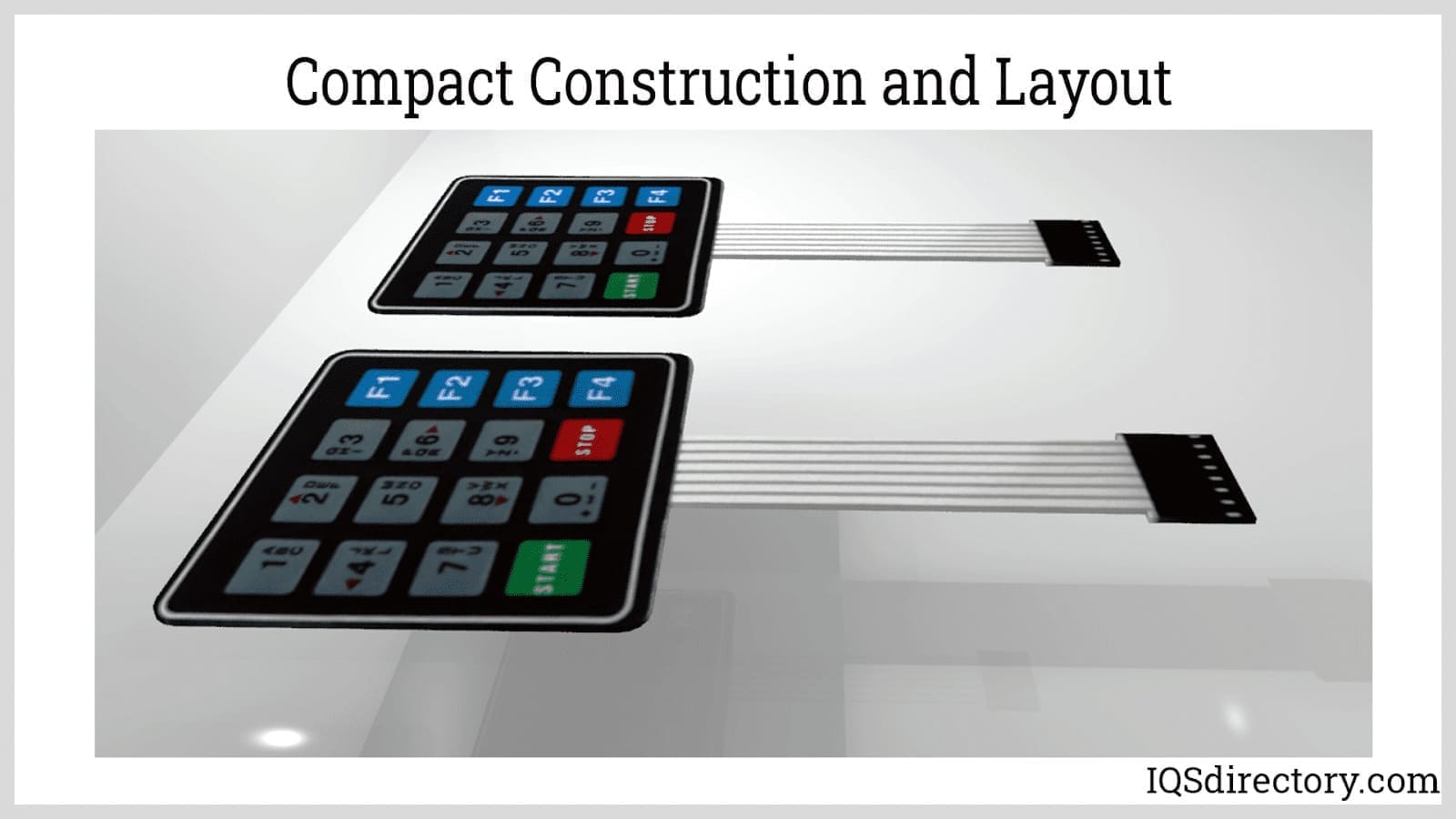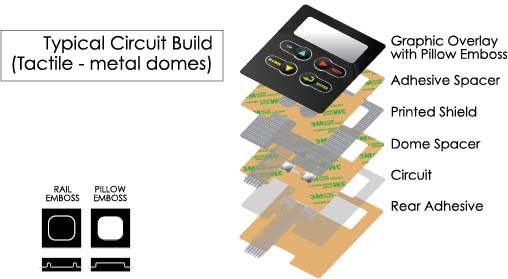Why Membrane Switches Are the Preferred Choice for Compact Devices
Why Membrane Switches Are the Preferred Choice for Compact Devices
Blog Article
Recognizing Membrane Layer Switches: The Secret to Reputable and durable Controls
Membrane layer changes represent a crucial element of contemporary user interface style, blending functionality with strength in different applications. These functional elements not just facilitate individual interaction however are also crafted to endure the roughness of demanding atmospheres, from medical devices to commercial equipment. Recognizing their construction, operation, and the myriad benefits they provide is necessary for developers and engineers alike. As we explore the complexities of membrane layer switches, it becomes clear that their duty in enhancing control systems is both profound and complicated, questioning regarding just how ideal to utilize their capacities in future advancements.
What Are Membrane Layer Switches?
Membrane buttons are an advanced remedy in the world of interface innovation, incorporating capability and layout seamlessly. These devices function as an interface between customers and digital systems, integrating numerous components right into a portable layout. Normally created from flexible, slim layers of materials, membrane buttons are designed to react to touch, making it possible for individuals to communicate with equipment and digital gadgets effectively.
The main elements of a membrane button consist of a published circuit layer, visuals overlay, and a spacer layer that protects against unintended activation. The visuals overlay can be tailored to reflect brand identity or customer preferences, enhancing appearances while guaranteeing functionality. Membrane layer buttons are frequently made use of in numerous applications, consisting of clinical tools, consumer electronic devices, and commercial tools, owing to their durability and resistance to environmental aspects such as dampness and dust.
Among the essential benefits of membrane switches is their ability to hold up against deterioration, making them ideal for high-traffic settings. Furthermore, they are light-weight and call for minimal room, allowing for innovative designs in item advancement. On the whole, membrane changes stand for a practical and reliable selection for contemporary digital interfaces, marrying innovation with user-centric layout principles.

Exactly How Membrane Changes Work
The procedure of membrane switches depend upon a simple yet reliable mechanism that translates user input into electronic signals. These buttons include several layers, normally consisting of a graphic overlay, a spacer layer, and a circuit layer. When an individual presses the button, the top layer warps, allowing a conductive aspect in the circuit layer to reach a matching conductive pad on the bottom of the graphic overlay. This get in touch with closes the circuit and sends a digital signal to the gadget, suggesting that the switch has been activated.
The style of membrane layer buttons can vary, yet they commonly integrate domes or tactile elements to supply comments to the customer, improving the overall experience. The products used in membrane layer buttons, such as polyester or polycarbonate, add to their durability and resistance to ecological elements, including moisture and dust. Furthermore, the published circuits are usually encapsulated, which protects them from deterioration over time.

Benefits of Membrane Layer Buttons
One of the key benefits of membrane layer switches is their flexibility in layout, allowing them to be customized to fulfill specific customer requirements and aesthetic demands. This flexibility reaches different markets, where different forms, sizes, and shades can be used to boost individual interaction and aesthetic charm.
Additionally, Going Here membrane switches are recognized for their durability. Built from durable products, they are immune to dust, moisture, and physical wear, which dramatically prolongs their life-span compared to traditional mechanical switches. This resilience makes them particularly appropriate for high-traffic atmospheres and applications requiring durability.

Moreover, membrane layer switches provide a streamlined profile, bring about a thinner style that can be incorporated into numerous tools without adding mass. This attribute not only improves the aesthetic charm yet likewise contributes to a much more ergonomic product style.

Applications of Membrane Layer Buttons
Flexible and straightforward, membrane buttons find applications across a large range of sectors, consisting of medical devices, consumer electronic devices, and commercial equipment. In the medical field, these buttons are indispensable to gadgets such as diagnostic devices, patient tracking systems, and infusion pumps, where integrity and convenience of cleansing are critical. Their capacity to stand up to extreme settings and maintain performance makes them excellent for such applications.
In customer electronic devices, membrane switches are utilized in items like microwaves, washing machines, Discover More Here and remotes - membrane switch. Their smooth style permits instinctive interface, boosting the total user experience while giving resilience and resistance to tear and put on
Industrial tools likewise gains from membrane layer switches, specifically in control panels for equipment and automation systems. These switches supply protection versus dust and dampness, ensuring consistent performance in difficult settings. Their customizable features allow manufacturers to customize them to specific functional needs, enhancing efficiency and capability.
Selecting the Right Membrane Change
When choosing a membrane layer switch, it is necessary to think about different aspects that affect efficiency and suitability for specific applications. The key considerations consist of ecological conditions, tactile comments, sturdiness, and layout specs.
First, examine the operating environment; buttons exposed to dampness, chemicals, or severe temperature levels require specific materials to ensure longevity and performance. Next off, examine the requirement for tactile responses. Relying on customer communication, some applications might take advantage of a responsive feedback to confirm activation, while others may prefer a non-tactile design for visual reasons.
Durability is an additional important element; membrane layer buttons should be designed to hold up against regular use, impacts, and abrasion. Make sure the chosen switch can endure the expected lifecycle, particularly in high-usage scenarios.
Conclusion
Finally, membrane layer switches over offer as essential elements in the design of reputable and sturdy control systems throughout various industries. Their small layout, combined with robust construction and personalized functions, improves individual interaction while making certain durability popular atmospheres. The versatility of membrane layer changes permits customized remedies that satisfy particular functional requirements, enhancing their significance in modern-day technology. membrane switch. As industries remain to develop, the importance of incorporating useful source efficient membrane switch remedies can not be overemphasized.
Membrane layer switches represent an important facet of modern-day user interface design, mixing functionality with durability in different applications.Membrane switches are an innovative remedy in the realm of customer interface technology, combining functionality and layout effortlessly. Typically built from flexible, thin layers of products, membrane switches are made to respond to touch, enabling individuals to communicate with equipment and electronic devices successfully.
The layout of membrane switches can differ, yet they commonly include domes or tactile elements to give comments to the individual, improving the general experience.In verdict, membrane changes offer as crucial elements in the layout of reliable and resilient control systems across different sectors.
Report this page